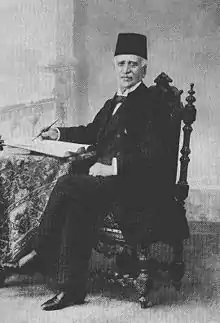Mirza Malkam Khan
Mirza Malkum Khan - Joseph (Hovsep) Melkumyan (1834 - 1908), also spelled as Melkum Khan, was a prominent Iranian modernist, preoccupied with the transformation of Iran into a modern state. Armenian state figure, diplomat, enlightener, writer and publicist in Iran. Mirza Melkum Khan is well-known as social reformer and enlightener. He is the first Christian who has adopted the title of «MIRZA» in Persia. The most remarkable aspect of his work was his promotion of law, to bring about an orderly society in which royal power was subjected or Conditioned (Mashrut) to checks and regulations. He developed these ideas in a number of works, but most importantly in his newspaper Qanun (Law), which had a wide readership among Iran's modernists. As such, he can be considered one of the fathers of the Iranian Constitutional Revolution.
Mirza Melkum Khan | |
|---|---|
 Mirza Melkum Khan | |
| 1st Ambassador of Iran to Austria | |
| In office 1872–1878 | |
| Monarch | Naser al-Din Shah Qajar |
| Preceded by | Position created |
| Succeeded by | Emanuel Goldberger de Buda |
| Ambassador of Iran to the United Kingdom | |
| In office 1872–1889 | |
| Monarch | Naser al-Din Shah Qajar |
| Preceded by | Muhsin Khan Mo'in al-Molk |
| Succeeded by | Mohammed-Ali Ala al-Saltaneh |
| Ambassador of Iran to Germany | |
| In office 1878–1889 | |
| Monarch | Naser al-Din Shah Qajar |
| Ambassador of Iran to Italy | |
| In office 1899–1908 | |
| Monarch | Mozaffar al-Din Shah Qajar |
| Preceded by | Nariman Qawam al-Saltana |
| Succeeded by | Mohammad Ebrahim Ghaffari |
| Personal details | |
| Born | 1834 New Julfa, |
| Died | 1908 Rome, |
| Nationality | Iranian Armenian |
| Occupation | Politician, Diplomat |
| Profession | Publisher, Translator |
Biography
Melkum Khan was born to an Armenian Christian family in Iran[1] and educated at the Samuel Muradian school in Paris from 1843 to 1851. He later returned to Iran and entered government service. He was elected as instructor at the newly established Polytechnic in Tehran called Dar ul-Funun, in 1852. He went to Paris in the diplomatic service in 1857.[2]
Melkum Khan introduced societies similar to the Freemasons in Iran in 1859, and was exiled by Nasser ad-Din Shah for doing so in 1862. He was later pardoned and given a post at the embassy in Constantinople. There, two years later, he married the daughter of Arakel, a prominent Armenian, with the ceremony taking place in an Armenian church.[3] He returned to Tehran in 1872 as assistant to Grand Vizier Mirza Hosein Khan Moshir od-Dowleh, and became the chief of the Persian legation in London (and later ambassador) in 1872. He remained in the position until 1888, and lost his position in 1889 as the result of a scandal over selling a cancelled concession for a lottery.[2] Nasereddin Shah explains in his third trip's memoir, how he went to Mirza Melkum Khan's house an evening, met his wife and his three daughters two of them as old as 19-20 and the third one who was 6 at the time (1889).
From London, Melkum Khan attacked both the shah and Iranian government, and edited the news-sheet Qanun, which was banned in Iran but read by the shah and his ministers. Melkum Khan eventually became recognized as the most important Persian modernizer of the century, and he was later pardoned and reinstated as ambassador to Italy by Mozaffar ad-Din Shah in 1898 with the title of Nezam od-Dowleh. He remained ambassador to Italy until his death in 1908.[2]
References
- Lloyd Ridgeon, Religion and Politics in Modern Iran (I.B.Tauris, 2005), ISBN 1-84511-072-2. p. 14.
- Nikki R. Keddie, with a section by Yann Richard, Modern Iran: Roots and Results of Revolution (Yale University Press, New Haven, 2006), ISBN 0-300-12105-9. pp. 431-32.
- Algar, Hamid. Mīrzā Malkum Khān: A Study in the History of Iranian Modernism page 10 University of California Press, 1973. ISBN 978-0520022171
Further reading
- Mehrdad Kia, Pan-Islamism in Late Nineteenth-Century Iran, Middle Eastern Studies, Vol. 32, No. 1, pp. 30-52 (1996).